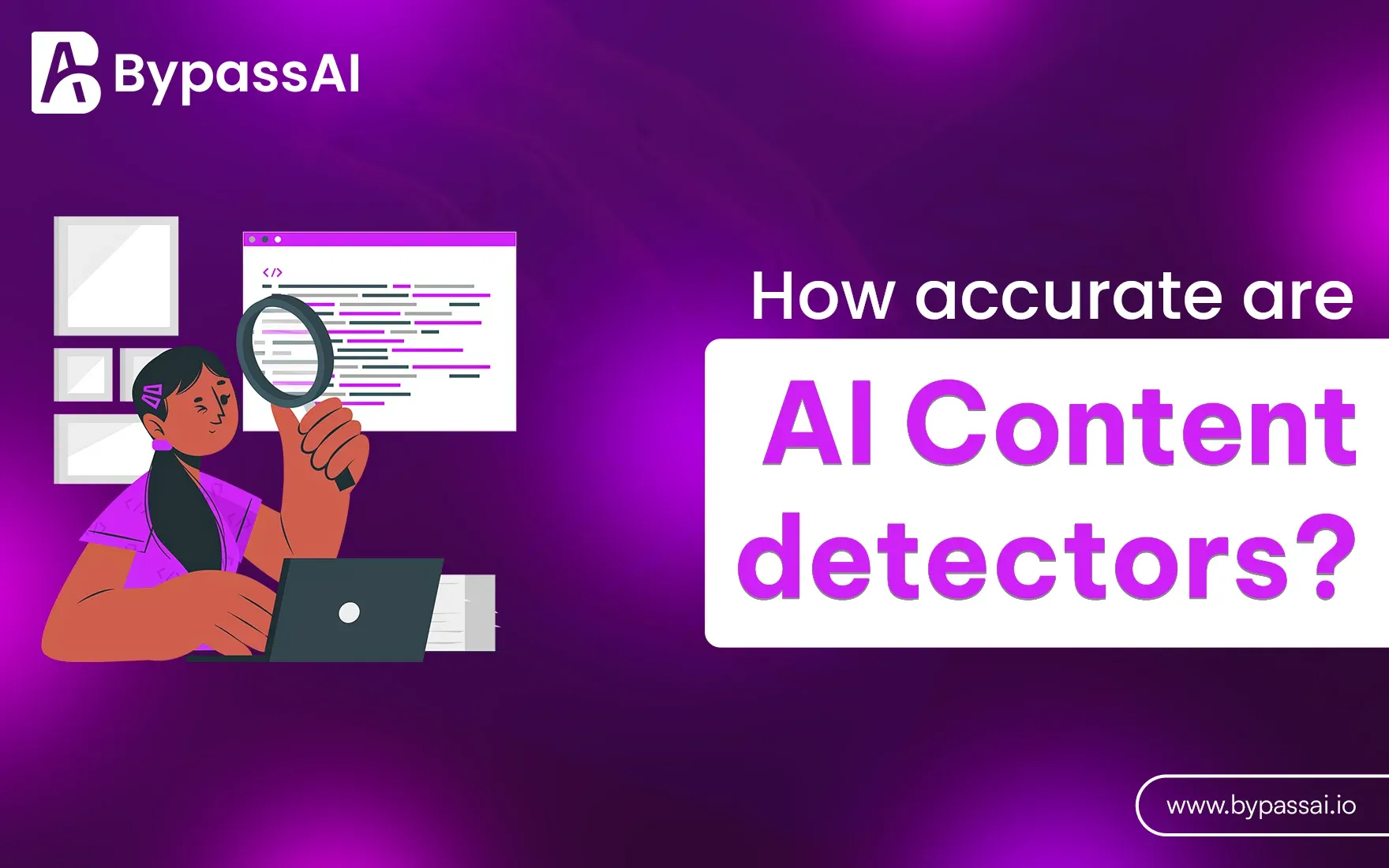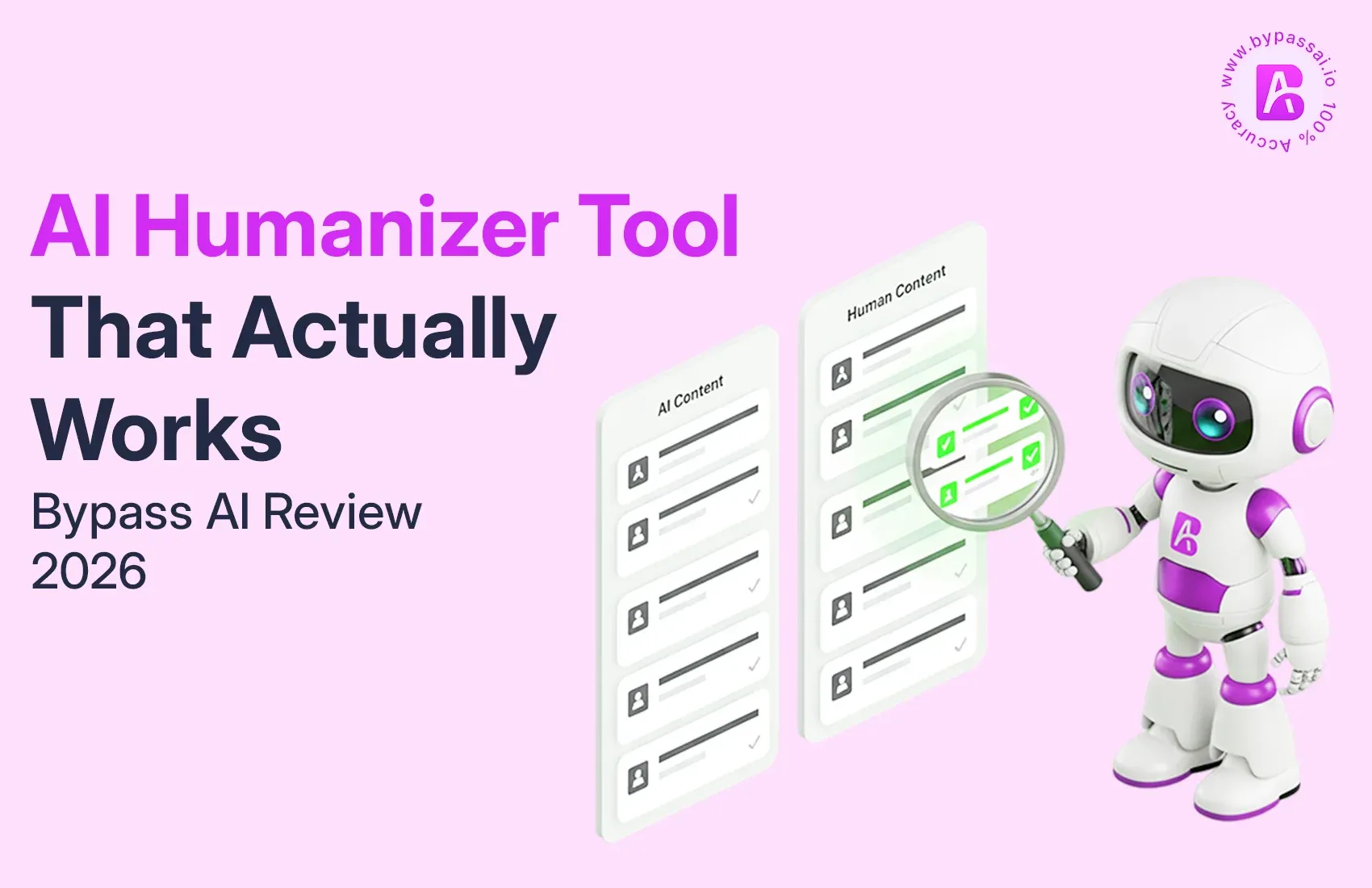Sign In
Welcome to Bypass AI! Sign in to continue your exploration of our platform with all its exciting features.
Forgot Password?
Don’t have an account ? Sign up
Sign Up
Embrace the Future with Bypass AI! Sign up now and let's rewrite the possibilities together.
You have an account ? Sign In
Enter OTP
We’ll send you an OTP on your registered email address
Back to Login
Forgot Password
We'll Send You An Email To Reset Your Password.
Back to Login
Enter OTP
We'll send you an email to reset your password.
Back to Login
Confirm Password
Please enter your new password.
TABLE OF CONTENTS
Quick Summary
Ever heard of AI Detectors?
Wondering about how AI Detectors function?
Can We Trust AI Writing Detectors?
Do AI Detectors Make Mistakes?
What does False Positive mean in AI Detection?
Finding a Trustworthy AI Content Checker
Tricking AI Detectors
Key Points
Conclusion
FAQs
The fast progress of AI has reshaped how we create content. AI writing tools can now produce articles, blogs, and many types of written materials. This rise in AI-written content led to the creation of AI content detectors. Their job is to tell the difference between human and machine-written text. But doubts have appeared about how accurate are ai detectors. This article explores this issue. It looks at how AI content detectors work, questions are AI detectors reliable, and discusses ways to get around these systems, like using the novel bypass AI humanizer.
Quick Summary
AI content detectors aim to spot text created by AI systems. Despite their advancements, their precision differs. Features like erroneous detection and advancements in AI authoring tools impact their dependability. Knowing how these detectors function and their weak points lets users make smart choices about using them.
Ever heard of AI Detectors?
These are special software made to spot if a human or AI made some content. By looking at how text is patterned, how language is structured, and other signs, they can tell human work apart from AI work. They are used in many areas, like schooling, news writing, and online advertising, to keep content real and honest.
Detecting AI has become more important as AI writing aids, like OpenAI's GPT-3 and GPT-4, make content that looks just like what a human would write. To find hidden signs of AI writing, these detectors use smart methods. Spotting AI is extra vital in areas where the realness and truth behind content is super important.
Wondering about how AI Detectors function?
AI detectors apply machine learning tactics to scrutinize and review written material. They are developed with enormous data samples that include human-made and AI-created content. By grasping the fine variances in writing patterns, word appliance, and sentence formations, these detectors can detect and alert when content seems to be AI-produced. Vital technologies used here are:
- Natural Language Processing: NLP helps detection systems grasp and decode the way we speak and write. It aids in breaking down sentences, analyzing grammar, and figuring out meanings.
- Machine Learning Models: These are trained for spotting typical traits of AI-written text. They judge new material based on what they have been taught.
- Statistical Analysis: This works to spot oddities and irregularities in written work. For instance, an AI might overuse phrases or styles that most humans do not use.
These tools team up to thoroughly review text. This helps detectors tell the difference between content made by humans or AIs, with a range of precision.
Also read this article : What is the best way to detect AI content?
Can We Trust AI Writing Detectors?
There is a discussion about are AI detectors accurate. Although lots of detectors boast about being very precise, how well they work can change due to different aspects:
- Data for Training: The effectiveness of detecting tools leans heavily on the quality and different types of training data. More reliable detectors usually have training from various texts.
- Advanced Techniques: High-tech algorithms often give better results. But, even advanced ones may have trouble with complex writing styles.
- Growing AI Tools: When AI writing tools get better, they can create harder-to-find text. This continuous growth makes a big problem for AI finders.
These detectors' trustworthiness partly depends on how well they can adjust to fresh writing trends and methods. It is vital to frequently update and enhance the algorithms to keep the precision advanced.
Do AI Detectors Make Mistakes?
They surely do. The mistakes that AI Detectors can make usually fit into two kinds:
- False Positives: This happens when content written by humans is mistakenly tagged as AI-created. It may occur when the writing style of a person strongly resembles AI patterns.
- False Negatives: This happens when information produced by AI can pass as human work. Such situations arise when AI systems generate text that closely matches human writing style.
These errors mean that AI detectors are not perfect and must be constantly updated. Misidentification can be harmful, especially in situations involving scholarly work where actual content matters.
What does False Positive mean in AI Detection?
False positives occur when an AI detector marks human-written content as if it was generated by AI. This is not ideal and can lead to issues, especially in areas such as academia or professional work where being authentic is paramount. False positives can occur because:
- Different Writers: Writers who write in a different style can sometimes mess up our system. They can use words, phrases, or lingo that sound like they came from AI.
- Not Enough Learning Resources: Identification tools that do not provide enough information can lead to errors. Real human writing is thought to be the result of AI. If the tool does not recognize enough human typing, it may not always produce results.
AI detectors can lose credibility because of false positives, putting the spotlight on the need for better and more varied training datasets.
Finding a Trustworthy AI Content Checker
To choose a trustworthy AI content checker, keep in mind a few key aspects:
- Reputation and Comments: Choose checkers with good user comments and a solid reputation within the field. User input can give you helpful information about the tool's efficiency.
- Honesty: Pick tools that are honest about their training data and processes. The information about how the checker works and its data source is vital to building trust.
- Regular Upgrades: Trustworthy checkers should upgrade regularly to stay current with AI writing tool progress. Ongoing enhancements help maintain precision and trustworthiness.
Weighing these aspects can assist in picking an AI content checker that fits your needs and gives dependable outcomes.
Ensure Your Content Evades AI Detection? Evaluate your content with Bypass AI Content Detector to keep your work genuine and undetectable.
Tricking AI Detectors
To trick AI detectors, one must tweak AI-created content to look more like it was written by a person. This includes
- Sentence Revisions: Manually adjusting the AI-written content for greater naturality. This may involve revamping sentence frameworks, introducing colloquial expressions, and diversifying wording.
- Word Swaps: Taking specific words and swapping them out with like-terms to derail pattern detection. It proves valuable when looking to mask regular or odd word use in AI-crafted content.
- Use AI Concealer: This handy device adjusts AI-created content to boost its resemblance to human text, making it less noticeable by AI detectors. The AI concealer can weave in slight changes and real language subtleties into the text.
These strategies can make it harder for detectors to spot AI-crafted content, requiring careful and sensible use, though.
Key Points
Tools called AI content detectors help spot text made by AI. How good they are depends on the quality of the data used for training and how advanced the algorithm is. It is common for a detector to make mistakes like false positives and negatives. It is really important to pick a good detector and know its flaws to use it well. People can use different tactics to get around AI detectors, like a special tool known as the bypass AI humanizer.
Conclusion
AI detectors that catch AI-written text are super important today. They help keep real, human content honest and real, even when there is lots of AI content around. But these detectors are not always perfect, so we need to know how they work, and what they can not do. Also, neat tech such as the bypass AI humanizer can help people get around AI detection. It is a little tricky, but it can be done. As AI grows and changes, keeping a balance between detecting and creating AI text will stay super important.
FAQs
1. How good are AI detectors?
The correctness of AI detectors depends on the quality of their learning data and how advanced their algorithm is. Although many promise high success, they are not perfect.
2. Can we always rely on AI detectors?
The trustworthiness differs. Detectors might face problems with incorrect flags, known as false positives and negatives, which can affect overall reliability.
3. How precise are AI detectors?
Precision can change a lot. Even though some detectors are very accurate, the ever-changing nature of AI tools may test their usefulness.
4. What does 'false positives' mean in AI detection?
False positive is the term for when content, written by a person, is wrongly marked as created by AI.
5. Is there a way to trick AI detectors?
Rewording sentences, using different words that have the same meaning, and making use of tools like the bypass AI humanizer are ways to outsmart AI detectors.




